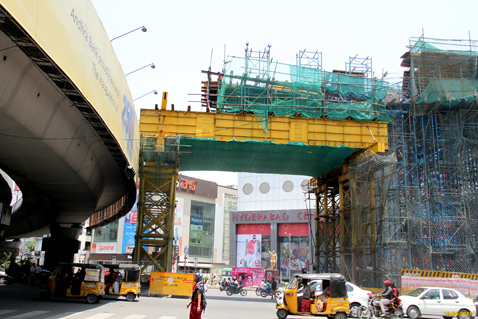 The first leg of the Chennai metro rail was recently commissioned, making it one more case of a metro project built on EPC basis. With one more success for EPC, it appears that PPP modality for metro rail projects is headed for a gradual demise. Not only are EPC cases on the rise, the string of cases where the PPP route has failed is only getting longer. Projectmonitor, in this special report, strongly feels that PPP in metro rail might just not stage a comeback.
The first leg of the Chennai metro rail was recently commissioned, making it one more case of a metro project built on EPC basis. With one more success for EPC, it appears that PPP modality for metro rail projects is headed for a gradual demise. Not only are EPC cases on the rise, the string of cases where the PPP route has failed is only getting longer. Projectmonitor, in this special report, strongly feels that PPP in metro rail might just not stage a comeback.
In the metro rail space, India has two big examples of the PPP deployment—Mumbai (Line 1) and Hyderabad. Given that PPP metro projects have proved very “costly” for developers with contentious issues dogging the project whilst under execution as well as in operation, it is unlikely that private developers would be forthcoming to venture into metro rail projects.
While Mumbai (Line 1) was seen as a big triumph for the PPP culture in metro rail, there were serious differences between the developer Reliance Infrastructure and the nodal agency MMRDA. Apart from inordinate delays during the construction phase, largely due to difficulties in land acquisition, differences also emerged on the fare structure when the metro line was put into operations. Reliance Infrastructure that was to develop Line 2 of the Mumbai metro pulled out of the project as it claimed that the state government did not fulfil some critical obligations. The concession agreement signed in July 2010 was rescinded in November 2014, with mutual consent of both parties. Line-2, a 32-km elevated section from Charkop to Mankhurd via Bandra, will now be developed with equity participation from both Central and state governments. A new government entity Mumbai Metro Railway Corporation Ltd (MMRCL) will execute Line-2 and also the underground Line-3 between Colaba and Bandra. Incidentally, nine consortia are in the fray for the civil contracts for Mumbai Line-3. Contracts are expected to be awarded in September with work envisaged to start in December this year. The civil works involve setting up twin tunnels of 33.5 km, with 26 underground tunnels.
Experts feel that in the Indian context, the PPP route might not be advisable for metro rail projects given the inherent difficulties. As metro rail projects aim to decongest a crowded city of vehicular traffic, land acquisition will always be a very difficult task. Serious delays could arise in the process of relocation and rehabilitation of project-affected people, and in working out fair compensation for land owners. Interacting with Projectmonitor, Arumugham Shankar, National Director – Strategic Consulting, JLL India, concurred that the major challenge pertaining to land acquisition is arriving at the right and satisfactory compensation to the affected persons and land owners. Shankar suggested that the transaction process and documentation needs to be transparent to bring in trust to the land owners. (See Box “Arriving at satisfactory land compensation is challenging” for detailed interaction with Arumugham Shankar.) Management of traffic congestion in the project execution phase is also an extremely challenging job. There are too many state government agencies involved and it is almost impossible for the private developer to coordinate with all of them, and simultaneously focus on project implementation.
Private developer Larsen & Toubro, in September 2014, had reportedly threatened to pull out of the Hyderabad metro rail. The Hyderabad metro rail is in fact the world’s biggest metro network on PPP basis, with a total length of 72 km, and a total cost of over Rs.16,000 crore. The developer had cited reasons of non-viability and non-availability of right of way. The project is running at least 15 months behind schedule and there has been a cost escalation of Rs.3,000 crore, it is estimated. After the recent bifurcation of undivided Andhra Pradesh, serious doubts were expressed on the project viability. The entire economic complexion of capital city Hyderabad changed after the bifurcation negatively impacting prospects of the Hyderabad metro project. However, the project is now on track with substantial completion of physical work but with no formal commissioning date announced.
In an exclusive interaction with Projectmonitor, V.B. Gadgil, Chief Executive & Managing Director of the concessionaire L&T Metro Rail (Hyderabad) Ltd observed that several challenges were encountered on all fronts during the execution of the Hyderabad metro rail. In the pre-construction stage, difficulties were faced because no comprehensive map of underground utilities was available. Encumbrances related to land, such as acquiring continuous right of way and acquisition of private land, were also responsible for delays in project execution. On support that government agencies should extend to metro rail concessionaires, Gadgil felt that though several opportunities were available in the metro sector, government should ensure that coordinated approvals from different government agencies both at the Central and state levels will definitely ease the pains presently being felt. Gadgil also averred that standardization of technical specifications and unification of the same across the country will help in a great way.
More cases: There are other cases where the PPP route failed. The Delhi metro project that is coming up on EPC basis experimented with the PPP philosophy for a 22.7-km segment providing connectivity with the Indira Gandhi International Airport. While state agency Delhi Metro Rail Corporation was to build the basic civil infrastructure for the line, private developer Reliance Infrastructure was to procure rolling stock and run the service. The collaborative venture never really took off. Reliance Infrastructure maintains that DMRC had failed to cure substantial defects in the civil structure. The concession agreement was called off with DMRC took over the operations in July 2013.
It may be mentioned that even when the Kochi metro rail in Kerala was first proposed, it was to be on PPP mode. Private players like Reliance Infrastructure were in contention till the implementation modality was changed to EPC in early 2008.
The Gurgaon metro rail is also an example, albeit smaller in scale, of PPP in metro rail. However, it cannot be regarded as a successful case of PPP, at least in light of its present condition. Private entity Rapid Metrorail Gurgaon Ltd (promoted by IL&FS) was formed with the primary intention of providing connectivity from the Delhi Metro Sikanderpur Station to Gurgaon in Haryana, covering the Cyber City. This 5-km link is India’s first fully privately financed metro rail project in India. The company entered into a concession agreement with nodal agency Haryana Urban Development Authority. The project, completed in November 2013, suffered cost escalation of around 20 per cent largely because it did not receive timely approvals from authorities concerned. The current ridership is way below projected levels resulting in lower fare revenues. Secondly, actual ridership is much lower because the much touted Cyber City has not been able to generate the occupancy desired.
Following the huge success of the Delhi Metro, the propensity towards the EPC route is only getting amplified. PPP very much appears to be a nearly-closed chapter for urban metro rail in India with the Mumbai Line-1 and Hyderabad projects likely to remain as the only achievements, for a long time to come.













